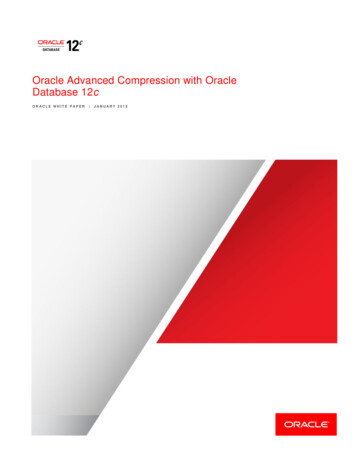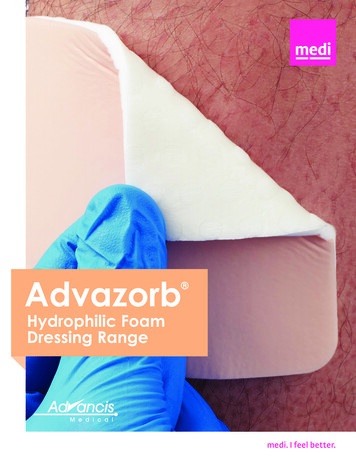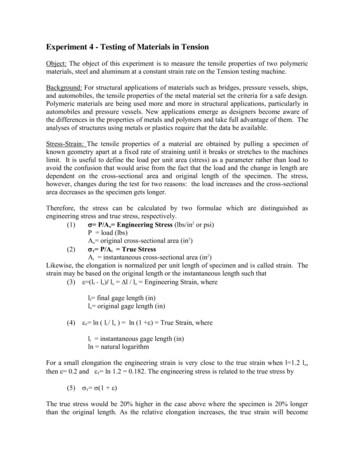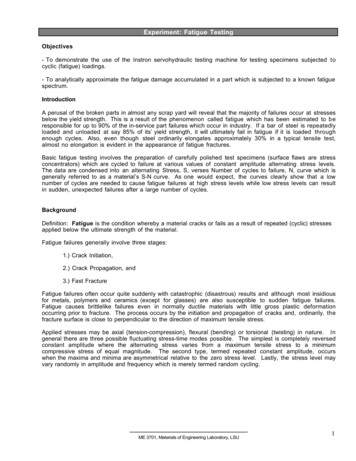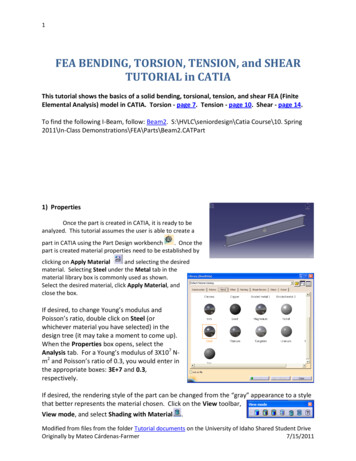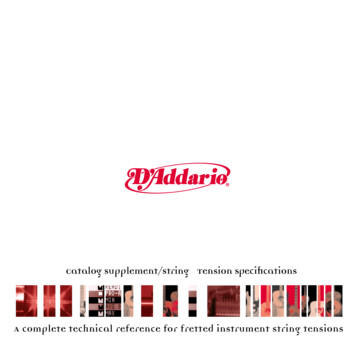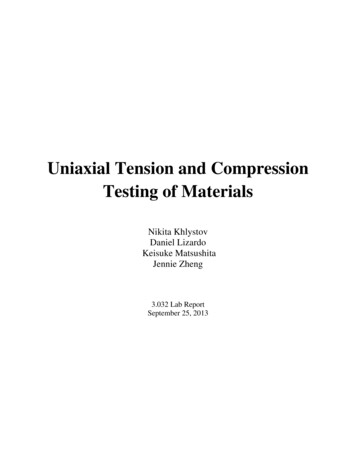
Transcription
Uniaxial Tension and CompressionTesting of MaterialsNikita KhlystovDaniel LizardoKeisuke MatsushitaJennie Zheng3.032 Lab ReportSeptember 25, 2013
I. IntroductionUnderstanding material mechanics is critical for engineering. The uniaxial tension andcompression tests provide a simple and effective way to characterize a material's response toloading. By subjecting a sample to a controlled tensile or compressive displacement along asingle axis, the change in dimensions and resulting load can be recorded to calculate a stressstrain profile. From the obtained curve, elastic and plastic material properties can then bedetermined. Therefore, to investigate material mechanics and gain experience in uniaxial testing,we performed compressive and tensile tests on alloys, pure metals, and ceramics, and calculatedtheir Young’s modulus, yield stress, ultimate tensile strength, and elastic strain energy density.1.1 Uniaxial testingFor uniaxial tests, the displacement is typically held at a constant rate, and displacementand resulting load are recorded. The load is measured by a series of strain gages, or “load cell,”while the displacement can be recorded as displacement of the crosshead, or the beam on whichthe specimen load frame is mounted. For more precise load measurements, strain gages or anextensometer can be directly fixed to the specimen. To make direct comparisons betweenmaterials, loading responses must be normalized against sample geometry. Therefore, thedimensions of each sample are noted to compute stress and strain from load and displacement,respectively. Engineering strain can be calculated as:εe ΔL/Lo(1)
Where ΔL is the measured displacement and Lo is initial sample length along a single axis.Engineering stress can be calculated as:σe P/Ao(2)Where P is the applied load and Ao is the initial cross sectional area of the sample normal to theloading direction. In tensile tests, specimens typically have two shoulders and a gauge section inbetween, as so:Fig. 1.1 Typical tensile testing specimen1The shoulders are large so that they may be gripped by the testing apparatus. The neck, as aregion of reduced cross-sectional area, localizes stress and ensures that failure consistentlyoccurs near the middle. The cross sectional area, Ao, may be taken as that of the neck region.In compressive tests, specimens are typically cylinders.
1.2 The stress-strain profileWith the sample geometry, a stress-strain curve can then be generated from the recordedload and displacement. A typical stress-strain profile for a ductile metal resembles the following:Fig. 1.2 Typical stress-strain curve of a ductile metal2The material initially behaves in a linear elastic manner: stress and strain are linearly related, andon unloading, the deformation is recoverable. The slope within the linear elastic regime isYoung’s modulus, or the ratio of the engineering stress to engineering strain in the axis:E σe/εe(3)E characterizes the stiffness of a material in units of force per unit area (N/m2, or Pa). The areaunder the elastic portion of the curve therefore defines the elastic strain energy density in units of
energy per unit volume (J/m3):U σε(4)A material’s maximum capacity to elastically absorb energy is then the total area under thestress-strain curve’s linear elastic regime:Uelmax σyεy(5)Where σy and εy are the yield stress and yield strain at which linear elastic behavior ceases. Atlarger strains, material deformation becomes irrecoverable and non-linear, or plastic. Along withσy and εy, the 0.2% offset yield stress, or the stress that corresponds to 0.2% irrecoverable strainon unloading, is used as a convention to characterize the transition. In the plastic region, thematerial will also exhibit its ultimate tensile stress, or the maximum load divided by the initialcross-sectional area:σult Pmax/Ao(6)To gain experience in uniaxial testing and better understand material mechanics, we willobtain E, σy, σmax, εmax, and Uelmax of pure metals and alloys, as well as ceramics. Differences intheir atomic structure will account for differences in their mechanical properties. For example,alloys typically have larger values of E than their pure counter-parts, due to the presence ofsubstitutional atoms which impede the movement of dislocations. Ceramics will exhibit brittle
behavior and high stiffness relative to metals, due to the directionality of their covalent bonds.Covalent bonds of a ceramic will resist deformation when a force is applied, but break when thethreshold is passed, whereas the delocalized nature of the bonds in metals allows for plasticdeformation, or ductile behavior.2. Materials and Methods2.2 Uniaxial TensionFor this section of the laboratory experiment, a metal (Cu, 99.3%) and three metal alloys(α-brass [64.5% Cu, 35% Zn, 1% Pb], aluminum 6061, and steel 1045) were subjected touniaxial tension using the Instron Model 4505. The samples were dog-bone structures to localizethe point of failure to the center of the samples during testing (Fig. 2.1). The initial sampledimensions (width and thickness) were measured, and then the samples were mounted into thefixed lower base of the Instron 4505 (Table 2.1, Fig. 2.2). The gage length L between the fixedlower base and upper fixture was measured to determine the initial length of the sampleundergoing uniaxial tension.Fig. 2.1 Copper, brass, aluminum, and steel samples for tensile testing. Each set of materialscontain samples before (right) and after (left) tensile testing.
SampleSteelAl 6061CuBrassWidth (mm)6.5726.6056.356.34Thickness (mm)1.6661.61.551.55Initial L (mm)66.1565.5765.861.19Table 2.1 Initial gage dimensions (width, thickness, and initial length, in mm) of the specimens.Fig. 2.2 Brass sample between the lower base and upper fixture that had undergone uniaxialtensile testing.Using the Instron Series IX Software, the force-displacement responses of each of the material ata displacement rate of 15 mm/min were acquired. The tests ended when the specimens fractured.After testing one sample of each material, a second round of tensile tests were performed on boththe brass and steel samples to observe variations in mechanical properties for a single material.
2.1 Uniaxial CompressionThis section of the laboratory experiment involved subjecting Cu (99.3%), α-brass (64.5%Cu, 35% Zn, 1% Pb), aluminum 6061, steel 1045, and alumina (porous and non-porous) touniaxial compression using the Instron Model 4206 (Fig. 2.3). Two measurements of the initialgage dimensions of the specimens were taken and averaged to obtain the dimensions that appearin Table 2.2. The samples were then placed between the compression anvils to commenceuniaxial compression testing (Fig. 2.4).Fig. 2.3 Porous Al2O3, Non-Porous Al2O3, aluminum, brass, steel, copper. Each pair of materialscontain samples before (left) and after (right) compression testing.SampleSteelAl 6061CuBrassHeight (mm)38.0538.1938.1338.12Diameter (mm)12.6612.7512.7612.68Table 2.2 Initial gage dimensions (height and diameter, in mm) of the specimens.
Fig.2.4 Aluminum sample between the compression anvils.To measure the strains of the samples within the elastic range, the specimens were loaded intothe Instron 4206 with the extensometer directly attached to the sample. The samples were thenunloaded, had the extensometer removed, and then compressed again up to a 5 mm maximumdisplacement. A second limit of 100 kN was set to protect the instrument from applying a loadgreater than its capable load. The extensometer-loading test was not performed on the porousand non-porous alumina. Bluehill 2 Software V2.6 was used to generate force-displacementcurves.2.3 Calculation of Mechanical PropertiesThe force-displacement responses were re-plotted in terms of engineering stress andstrain to calculate E, σy, σmax, εmax, and Uelmax. Using the measured dimensions of the samplesand Eqn. 1, 2 and 3, the Young’s modulus, E, was calculated. The yield stress, σy, wascalculated by determining the 0.2% offset yield strain, forming a line with a slope equal to the
Young’s modulus with that yield strain as the x-intercept, and locating the point where this lineintersected the stress-strain curve. The values for yield stress and yield strain were used alongwith Eqn. 5 to calculate values for Uelmax , the material’s maximum capacity to elastically absorbenergy. The maximum stress and strain for the uniaxial tension tests were determined by findingthe local maximum of the stress-strain curve before fracture of the samples occurred.3. Results3.1 Uniaxial TensionFigure 3.1 shows the measured stress versus strain data for brass, aluminum (alloy 6061),copper, and steel specimen tested under tension. Two specimens each of brass and steel weretested. The four different types of metals featured varying behaviors under tension, highlightingtheir different mechanical properties (Table 3.1). Brass underwent the greatest amount ofnecking, and accordingly its strain at failure (31.2%) was the greatest out of the four metals.Steel was found to be comparably ductile (17.6%), while aluminum (6.3%) and copper (0.5%)were more brittle. Steel was found to be the strongest of the four metals with an ultimate tensilestrength of 515.8 MPa, while brass was close at 461.5 MPa. Although relatively brittle, copper’sultimate tensile strength (373.8 MPa) is greater than that of aluminum (274.5 MPa). A similarranking was observed for the metals’ behavior in yielding: steel had the highest yield strength(162.6 MPa), followed by brass (118.7 MPa), copper (95.6 MPa), and aluminum (73.0 MPa).Steel was found to be considerably tougher than the other three metals, having an elasticmodulus of 74.22 GPa. Copper’s toughness (E 53.22 GPa) was comparable to that of brass (E 58.03 GPa), while aluminum (E 38.16 GPa) was found to be the most elastic of the metals.The energy stored in tension for the four metals was similarly ordered, with steel and brass
having the highest maximum stored elastic energy (121 and 128 kJ/m3 respectively). Coppertolerated a moderate amount of tensile energy before yielding (95.4 kJ/m3) while aluminumyielded under the least amount of tensile energy (74.0 kJ/m3).Stress vs. Strain (Tensile)600Tensile Stress (MPa)500400Brass Trial 1Brass Trial 2300AluminumCopper200Steel Trial 1Steel Trial 2100000.050.10.150.20.250.30.350.4Tensile Strain (mm/mm)Fig. 3.1 Tensile stress versus tensile strain data as measured for 6 different specimen including brass,aluminum, copper, and steel.MaterialAl 6061CuBrassSteelE (GPa)38.1653.2258.0374.22 y (MPa)73.095.6118.7162.6UTS (MPa)274.5373.8461.5515.8 Max (MPa)271.5332.5445.9508.0 Max0.0630.0050.3120.176Table 3.1 Tensile mechanical properties for aluminum, copper, brass, and steel3.2 Uniaxial CompressionUelMax (kJ/m3)74.095.4121128
The stress-strain behavior of the four metals under compression is shown in Fig. 3.2 and Fig. 3.3,measured with and without an extensometer, respectively. Data obtained with the extensometer weresubject to initial measurement error, as the reported strain values deviated below zero during the firstmoments of compression. The data collected with the extensometer focused on the elastic regime ofdeformation of the four metals, and the calculated mechanical properties under compression (Table 3.2)showed that steel was tougher (E 259 GPa) than the other three metals. Brass (E 52.3 GPa) andaluminum (E 61.3 GPa) were the most elastic under compression, while copper was only slightlytougher (E 100 GPa). Fig. 3.2 presents data from the broader regime of compressive deformation, anddemonstrates that steel by far is the strongest of the four metals with a compressive yield stress of 427.6MPa. Concordantly, steel absorbed the greatest amount of elastic compressive energy (249 kJ/m3); brass(112 kJ/m3) and aluminum (122 kJ/m3) tolerated the least amount of compressive energy before yielding,while copper absorbed 197 kJ/m3 of energy before yielding. Similarly, brass (136.4 MPa) and aluminum(165.4 MPa) were found to be the weakest, with copper being slightly stronger with a yield stress of 217.1MPa. According to Fig. 3.2, the failure mechanism of steel appears to be more prolonged than those of theother three metals, which underwent buckling more immediately and, as evident in the lower slope ofplastic deformation, offered less resistance to applied stress after yielding.
Stress vs. Strain (Compression with Extensometer)500450Compressive Stress essive Strain (mm/mm)Fig. 3.2 Stress-strain behavior for the four metals as measured with an extensometer. Strain values werelimited to the elastic regime below 0.2% strain.
Stress vs. Strain (Compression w/o Extensometer)8000Compressive Stress 0001000000.020.040.060.080.10.120.14Compressive Strain (mm/mm)Fig. 3.3 Compression stress-strain behavior of the four different metals, measured without anextensometer and at higher values of strain.MaterialE (GPa)UelMax (kJ/m3) yield (Mpa)Al l259427.6249Table 3.2. Compressive mechanical properties for aluminum, copper, brass, and steel
4. Discussion4.1 Trends and AnalysisFor the metals, our data generated stress-strain profiles that reflect their theoretical properties,exhibiting distinct regimes of elastic and plastic behavior. Their linear elastic slopes are distinct, but theoverall material behaviors are comparable: the values of E are all roughly the same order of magnitude,and the profiles look similar, reflecting the fact that the metallic bonding accounts for many of themechanics. The accuracy of the values, however, is questionable due to various sources of error discussedlater in this section.The differences in the metals’ mechanical properties are most evident the plastic regimes of thestress-strain plots, where properties including toughness, ultimate tensile strength (UTS), and fracturestress and strain are determined. The tensile data in Fig 3.1 shows clearly that the pure metals (copper andaluminum) had the lowest toughness, UTS, and fracture strain, while materials with substituted atoms(brass) or a binary phase system (steel) showed much higher values for all of these, with brass having thegreatest energy absorption (toughness), and steel the highest ultimate tensile stress. This can be attributedto the fact that these alloys have an amount of substitutional atoms that are larger than the primary atom.This causes a local swelling of the crystal, areas which absorb extra strain energy and halt both slip planesand crack propagation, thus increasing the resistance to fracture.The compressive strain data Fig 3.2, Fig 3.3 was somewhat less informative as to the specificproperties, as the materials behavior was very similar, though it does show that steel, again, a binarysystem, was able to absorb the most energy, by a significant amount, though the noticeable area of theplot which is in the negative strain area, an artifact of the machine normalizing the stress on the inevitablyuneven sample surface, may bely what would seem to be a discrepancy (to some degree) there.
4.2 Error: Theoretical Values vs Experimental calculatedUTSliterature Al 606138.1GPa68.9 GPa57.6%274.5 MPa310 MPa12.1%Cu53.2 GPa110 GPa69.6%373.8 MPa210 MPa56.1%Brass58.0 GPa110 GPa61.9%461.5 MPa300 MPa42.4%Steel74.2 GPa200 GPa91.8%515.8 MPa585 MPa12.6%Table 4.1 Tensile mechanical properties for aluminum, copper, brass, and steelFrom Table 4.1, it is noticeable that the accuracies of the experimental values exist mostlyrelative to each other, as there is a large discrepancy between any of the values and their literaturecounterparts3. It seems that our experimental method produces data consistently much lower than thetheoretical values. The most fundamental part of this error is in the method for calculating theoreticalvalues and the method for determining accepted literature values. Theoretical elastic moduli arecalculated assuming single crystal, and the most accurate accepted values, for the sake of accuracy, aretested for using very small samples to ensure the fewest number of grains. Our test, however, usedrelatively large sample ( 66x6.5x1.5mm) that was most certainly polycrystalline with lots of grains,decreasing the tensile strength relative to a pure, single crystal metal or ceramic. So with this in mind, weassume any testing of this sort of sample would have a lower modulus than a theoretical value.Conversely, the fact that the samples were large and polycrystalline would increase the toughness, though,this specific value, we did not calculate. The large number of grains and therefore grain boundaries limitsthe spread of crack defects (thanks to the interrupted slip planes), and thereby toughens the materialoverall.4.3 Error: Sample HistoryAlso to consider is the sample history, which for all of the samples was largely unknown. Anynumber of events could have occurred in the history of the sample including stress from machining,
material fatigue, or even heat cycles. It’s unclear which did happen however, but we can be sure that noneof them increased the tensile strength of the sample, as there are few ways to do that, and any would haveto have been very deliberate.One very noticeable discrepancy with our data comes from one of the steel samples, and theresult suggests that this sole sample had some kind of defect that caused it to fail prematurely. Of the twosamples we tested, we found that the difference between the trials was much larger than with the otherrepeat trials. Specifically, the two values had a standard deviation of 19, orders of magnitude higher thanthe other repeat trials, which had deviations of no more than 0.3. This suggests one of the two sampleswas very far off the norm, leading to the much larger than normal percent difference of over 90%. Webelieve that had the sample not failed prematurely, we would’ve seen a percent difference back in ourrange of 50-70%4.4 Error: Sample Preparation and Machine Compliance (Instron Testing Machine4505 and 4206)Finally we have the machine compliance for our testing rig. The most obvious form of that is theorientation of samples as there was no self-orienting appliance in the machine. Any angle off of 90ºwould decrease the effective stress on the sample. The grips of the machine were intended provideentirely uniaxial stress to the sample, but the frictional elements are by no means perfect and some straindid occur outside of the length we considered. As elastic moduli are inversely proportionate to strain, anyexcess, ignored strain would decrease the calculated value.All of these sources of error serve to affect a much lower calculated value than one might’veexpected from theoretical or literature values3, and in our case, such a depression was on the order of 6070% across the board, but we can be confident about these values because the were consistent andaccurate relative to each other. In terms of future attempts of this specific lab work, one will struggle to
find much better data without spending exorbitant amounts of money one more precise machinery madeto take much smaller samples, but realistically, a level might help to ensure the stress vector is as straightas it could be, and more than one or two trials will support the consistency of the results though we arealready able to see that to some extent with our small number of trials. This would of course, also allowyou to calculate a distribution that quantitatively relates the aggregate of errors to percent difference fromliterature or theoretical values.5. ConclusionDespite the inaccurate values calculated for mechanical properties, the stress-strain curves fromwhich they were generated still conform to the expected profile and mechanics of metals: an initial regimeof linear elastic behavior followed by plastic deformation. Similarly, the ceramics exhibited hightoughness and brittleness, as expected of the directionality of their covalent bonds. The laboratoryexperiment provided a more physical understanding of material mechanics, as well as significantexperience in materials testing. Additionally, the process of identifying machine compliance as anexplanation to the consistently low values of material properties was a crucial exercise in determiningsource of errors. In this respect, the data we collected was incredibly informative—testing must bedesigned to produce not only data but data from which artifacts and systematic sources of error may bedetermined.6. AcknowledgementsWe would like to acknowledge Dr. Meri Treska and Franklin Hobbes for guiding us through thislaboratory module, as well as David Bono for providing technical assistance.
7. References1. "Materials Engineering." Main page [SubsTech]. N.p., n.d. Web. 22 Sept. 2013.2. Uniaxial Tension and Compression Testing of Materials, 3.032 Handout3. AMS Materials Data sheets, www.matweb.com
Sep 25, 2013 · material will also exhibit its ultimate tensile stress, or the maximum load divided by the initial cross-sectional area: σ ult P max /A o (6) To gain experience in uniaxial testing and better understand material mechanics, we will obtain E, σ y, σ max, ε max, and U el max of pu

